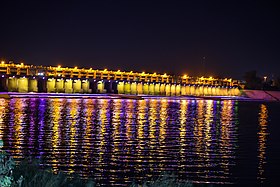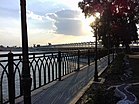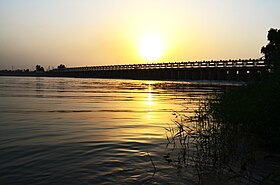Kut
Kut
ٱلْكُوت | |
|---|---|
City | |
| Coordinates: 32°30′20″N 45°49′29″E / 32.50556°N 45.82472°E | |
| Country | |
| Governorate | Wasit |
| Elevation | 23 m (75 ft) |
| Population (2019)[1] | |
| • Total | 315,162 |
Kūt (
the estimated population is about 389,400 people. It is the capital of the province long known as Al Kut, but since the 1960s renamed Wasit.The old town of Kut is within a sharp "U" bend of the river, opposite from the point where the
The Kut Barrage was constructed in the city in the 1930s to provide irrigation water for the surrounding area. The barrage supports a road and includes a lock for boats passing up and down the Tigris. Its purpose is to maintain a sufficiently high water level in the Tigris to provide water for the Gharraf irrigation canal.
In 1952, 26,440 hectares (65,300 acres) were irrigated from water provided by the Gharraf Canal. Of this newly reclaimed land, 14,080 hectares (34,800 acres) was distributed to small farmers as part of a social land reform program. These farmers received 10 hectares (25 acres) per family and were required to live on the land they farmed. In 2005, repairs and maintenance works were carried out at the Kut Barrage and the Gharraf Head Regulator for a total cost of US$3 million.
In 2021, a major car crash occurred inside the city in a travel route from Amarah (a neighboring city) to Baghdad, causing fatalities. The local hospital was reportedly ill-equipped to deal with the incident and could not air-lift victims back to Amarah for treatment and the large hospitals there, resulting in 5 casualties. The driver was pronounced dead from major injuries 4 days afterwoods, the incident rocked the town.
Geography
Climate
Kut has a
| Climate data for Kut | |||||||||||||
|---|---|---|---|---|---|---|---|---|---|---|---|---|---|
| Month | Jan | Feb | Mar | Apr | May | Jun | Jul | Aug | Sep | Oct | Nov | Dec | Year |
| Mean daily maximum °C (°F) | 17.1 (62.8) |
19.6 (67.3) |
23.6 (74.5) |
29.4 (84.9) |
36.2 (97.2) |
41.3 (106.3) |
43.5 (110.3) |
43.6 (110.5) |
40.5 (104.9) |
34.5 (94.1) |
25.8 (78.4) |
18.8 (65.8) |
31.2 (88.1) |
| Mean daily minimum °C (°F) | 5.1 (41.2) |
6.6 (43.9) |
10.1 (50.2) |
14.9 (58.8) |
20.4 (68.7) |
23.6 (74.5) |
25.7 (78.3) |
25.2 (77.4) |
21.6 (70.9) |
16.6 (61.9) |
11.1 (52.0) |
6.4 (43.5) |
15.6 (60.1) |
| Average precipitation mm (inches) | 26 (1.0) |
32 (1.3) |
19 (0.7) |
12 (0.5) |
5 (0.2) |
0 (0) |
0 (0) |
0 (0) |
0 (0) |
1 (0.0) |
17 (0.7) |
26 (1.0) |
138 (5.4) |
| Source: climate-data | |||||||||||||
History

The medieval city of Madharaya was at the site of modern Kut.[3][2][4] It lay at the point where the Nahrawan Canal flowed out into the Tigris.[2] Madharaya has been identified as the hometown of the Sasanian-era Zoroastrian religious leader Mazdak.[5] By the early 1200s, however, Yaqut al-Hamawi wrote that Madharaya was in ruins.[3]

Modern Kut owes much of its prosperity to the advent of steamboat transportation on the Tigris in the 1800s.[2]
World War I
Kut was the scene of a fierce battle during
After a halt of nearly nine months, Townshend then headed up river to
Kut suffered heavy damage during the First World War, and was almost entirely rebuilt afterward.[2]
Contingency Operating Base Delta (COB Delta)

In the early 21st century, the Contingency Operating Base (COB) Delta was an American military installation located on the right bank of the Tigris southwest from Kut. Designated as a
See also
- Anglo-Iraqi War
- List of places in Iraq
- List of United States Military installations in Iraq
References
- ^ "Geonames". geonames.org. Retrieved 30 September 2019.
- ^ a b c d e Naval Intelligence Division guidebook (1944), p. 543
- ^ a b Le Strange (1905), pp. 38, 60
- ^ El-Samarraie (1970), p. 29
- ^ Madelung (1988), p. 3
- ^ "FOB Delta not just enduring – it's growing".
- ^ "Saber Squadron arrives at COB Delta".
Sources
- Le Strange, Guy (1905). The Lands of the Eastern Caliphate: Mesopotamia, Persia, and Central Asia, from the Moslem Conquest to the Time of Timur. Cambridge: Cambridge University Press. OCLC 458169031.
- Madelung, Wilferd (1988). Religious Trends in Early Islamic Iran. Albany: Bibliotheca Persica. ISBN 0-88706-701-8.
- [1]
External links
![]() Media related to Al Kut at Wikimedia Commons
Media related to Al Kut at Wikimedia Commons
- ^ El-Samarraie, Husam Quam (1970). Agriculture in Iraq During the 3rd Century, A.H. London: University of London. Retrieved 12 March 2020.





